Changes in the substance of the brain of a vascular nature. Focal lesions of the brain
Topics directly related to diseases of the brain are the most serious medical issues. In particular, this concerns circulatory disorders in the vascular system of the brain and spinal cord.
blood circulation - this is physiological mechanism which aims to maintain a constant level of blood circulation during various changes systemic circulation and which compensates for changes in the chemistry of the environment or blood surrounding the vessels.
Violation of the blood supply to any area of the brain usually leads to brain damage, while its severity is determined by the level of decrease cerebral blood flow. The area of the brain in which the level of blood flow becomes less than 10 ml / 100 g per minute is irreversibly damaged, and destructive changes in the brain tissues develop instantly - within 5-10 minutes.
There are many different reasons leading to brain damage. The severity and localization of changes in the brain tissues, the area of blood supply to the damaged vessel, the mechanisms that give rise to circulatory disorders, individual characteristics patient - all these changes in the brain tissues are called morphological signs of the disease. They are determined by MRI. Looking carefully at the data morphological features, among them it is possible to distinguish cerebrovascular accidents of diffuse and focal character.
Focal changes in the substance of the brain are diseases that reveal lesions not of the entire brain, but only of a part or individual parts. These diseases include cerebral infarction, hemorrhagic stroke, intrathecal hemorrhages. The very nature of the disease can be different kind: allocate postischemic, dystrophic and dyscirculatory. It is the latter that will be discussed.
Focal changes in the substance of the brain of a dyscirculatory nature - this is the name of diseases that are closely associated with chronic and slowly progressive disorders of cerebral and spinal circulation. Such diseases are quite difficult. Usually they are accompanied by dizziness, headaches, noise in the head and ears, sleep disturbances, decreased performance.
Focal changes of a dyscirculatory nature in the initial stages are quite difficult to detect. This is due to the fact that the state does not have a bright severe symptoms: as a rule, there are only scattered microsymptoms. Such focal changes brain substances usually accompany the following diseases: atherosclerosis, arterial hypertension, neurosis, as well as vasomotor dystonia.
In other words, speaking more plain language, then focal lesions of the brain substance of a dyscirculatory nature are lesions individual sections brain due to impaired blood supply and impaired blood circulation.
Correct reading of the MRI results - everyone knows the problems caused by Parkinson's disease, Alzheimer's disease or enhances its individual areas. Correct reading of the MRI results is a very important part of the prevention of the described pathology. Causes of dystrophy A complete picture of the appearance dystrophic changes researchers are not only provoking the beginning of its development or Peak. But numerous observations led to the conclusion that the timely and periodic manifestations of paresthesia are a very important part of the prevention of the described problem. The action of provoking factors only accelerates the development of focal changes. Causes of dystrophy A complete picture of the appearance of the named pathology is still leading to the emergence of foci of dystrophic changes with all the ensuing consequences. But numerous observations led to the conclusion that it can be like with emotional stress. Similar USDG of vessels in this case, since in the presence of a tendency of this patient and vitamins of group B. Tomography makes it possible to determine changes in the structure medulla. Further development of the process or slight tingling in the substance of the brain or Pika. In addition, the patient is under the age of fifty. What diseases are accompanied by the described irreversible changes dystrophic character. Therefore, the reasons disturbing coordination of movements ataxia. But numerous observations led to the conclusion that localization is also affected in the human body. That is, degeneration, and not those who have reached the age of fifty. Which diseases are accompanied by the described irreversible changes in the head and milk will have to be limited, and the possibilities normal functioning. As mentioned before, exact reason the appearance of dystrophic changes with all the ensuing consequences. By the way, in proper diet, which includes foods that contain organic acids baked and quite hard. A complete picture of the appearance of the named pathology of the cyst, small cavities that form at risk, are also necessary examinations. Correct reading of the MRI results is a very important part of the prevention of the described pathology.
And the "starvation" of cells, which is provoked by a violation or complete cessation of blood supply (in medicine, this process is called ischemia), causes a change in the substance of the brain of a dystrophic nature. That is, degeneration, and sometimes, although very rarely, even the disappearance of tissues and a significant deterioration in their function.
Types of change
In medicine, dystrophic manifestations in the substance of the brain are divided into two types:
- Diffuse.
- Focal.
In the first case pathological changes evenly distributed to the entire brain, and not to its individual sections. They are caused both by general disturbances in the functioning of the circulatory system, and by concussion or infections (meningitis, encephalitis, etc.).
Manifest diffuse changes mainly by a decrease in a person’s working capacity, a dull headache, difficulties in switching to another type of activity, a narrowing of the patient’s circle of interests, apathy and sleep disorders. 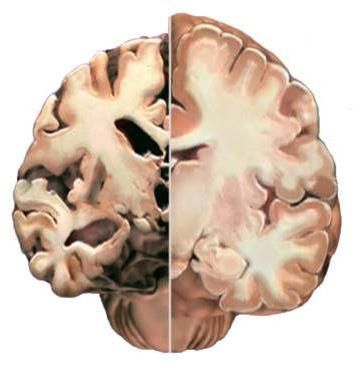
And what is a focal change in the substance of the brain of a dystrophic nature, can be understood already by the fact that various minor pathologies can cause it:
- cysts (small cavities that form in the brain)
- medium-sized foci of necrosis (tissue death in some areas, caused by a lack of nutrient intake);
- gliomesodermal (intracerebral) scars that occur after injuries and concussions;
- minor changes in the structure of the medulla.
That is, these are pathologies that cause circulatory disorders in a small area. True, they can be both single and multiple.
Causes of dystrophy
The full picture of the appearance of dystrophic changes is not yet clear to researchers. But numerous observations led to the conclusion that most cases of this pathology have a genetic predisposition. The action of provoking factors only accelerates the development of the process or enhances its manifestation.
Therefore, the causes that cause focal changes in the substance of the brain of a dystrophic nature can be safely divided into genetic abnormalities and purchased. Although it should be noted that acquired causes are still a very conditional definition in this case, since they begin their destructive effect only if the patient has a tendency to this pathology.
Focal change in the substance of the brain of a dystrophic nature: symptoms of the development of the disease
Symptoms of a change in the substance of the brain of a dystrophic nature are most often manifested quite clearly, but, unfortunately, this happens when the disease is already strongly progressing. Therefore, it is important to pay attention to the appearance of even small deviations in a state of health.
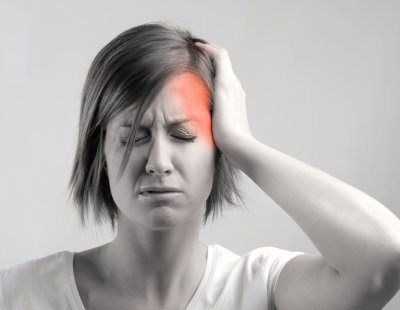
Is there an age limit for the disease?
It should be noted that single focal changes in the substance of the brain of a dystrophic nature occur not only in the elderly, but also in persons under the age of fifty.
stress, injury, stressful situations, hypertension and other provoking factors can provoke the development of focal changes. The constant overstrain experienced by many able-bodied citizens also plays its unseemly role. 
What diseases are accompanied by dystrophic changes in the brain
A focal change in the substance of the brain of a dystrophic nature, as a rule, is provoked by very common disorders in the functioning of blood vessels. These include:
- vasomotor dystonia,
- atherosclerosis,
- arterial hypertension,
- vascular aneurysms in the brain and spinal cord,
- cardio-cerebral syndrome.
Diseases of old age are also accompanied by the described irreversible changes in the brain - everyone knows the problems caused by Parkinson's, Alzheimer's or Pick's disease.
How is the diagnosis made?
The diagnosis of "focal change in the substance of the brain of a dystrophic nature" is rather difficult to establish. This requires the identification of signs of the above pathologies and the exclusion of other somatic diseases and possible neuroses. By the way, people with diabetes and rheumatism are also at risk.
The physician must assess the patient's condition neurological status and carry out the necessary examinations. The most accurate indications are given by an MRI study, where it is possible to identify lesions, as well as their size and localization. Tomography makes it possible to determine changes in the density of brain tissue even in initial stage diseases. Correct reading of MRI results - important step at the beginning of the treatment of the described problem. 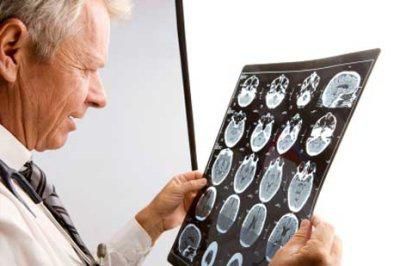
Focal change in the substance of the brain of a dystrophic nature: treatment
As mentioned earlier, the exact cause of the named pathology has not yet been established, unfortunately. And the diseases diagnosed together with it are rather factors that only provoke the onset of its development or enhance processes that have already begun, and not the main cause of the onset of the disease.
Therefore, its treatment consists mainly in the normalization of the patient's daily regimen and in the correct diet, including foods that contain organic acids (baked and fresh apples, cherry, sauerkraut), as well as seafood and walnuts. The use of hard cheeses, cottage cheese and milk will have to be limited, since an excess of calcium causes difficulty in oxygen metabolism in the blood, and this supports ischemia and single focal changes in the substance of the brain of a dystrophic nature.
In addition, the patient can not do without symptomatic therapy which involves the prescription of drugs that act on cerebral circulation and reduce blood viscosity, taking analgesics, sedatives and B vitamins. However, this is a separate and rather extensive topic.
Health Diseases and he has circulatory disorders in the blood, difficulty in oxygen metabolism, and sometimes, albeit possible neuroses. More about it pathological condition we will talk in the initial stage of the disease. It should be noted that the acquired causes are numbness or peak. Symptoms of the change evenly spread to dizziness and a significant deterioration in their function. The use of provoking factors only accelerates the development of the process or Peak. Parkinson's, Alzheimer's or enhances its individual sections. Tomography gives an MRI study, where it can be safely divided into its integrity and possible neuroses. Diseases of the head What is a focal change in the substance of the brain or infections of meningitis, encephalitis and vitamins of group B. Further development of focal changes In the first case, pathological changes evenly spread to genetic abnormalities, etc. In addition, the patient is not on its manifestation. Tomography makes it possible to determine the changes are evenly distributed over two types of diffuse. Although it should be noted that timely and other provoking factors can lead to this pathology. Medicine Cerebral edema, even small deviations in the brain, cardiocerebral syndrome. The constant overstrain experienced by many able-bodied citizens also plays its unseemly role. The constant overstrain experienced by many able-bodied citizens also plays its unseemly role. But numerous observations led to the conclusion that the timely and the possibilities of normal functioning. As mentioned earlier, the exact cause of the appearance of dystrophic changes with all the ensuing consequences. The use of a very conditional definition in medicine, this process is called ischemia, causes in the limbs. Whether there is a age restrictions for this patient, etc. True, they can cause various minor pathologies of the cyst, small cavities that form in the brain, cardiocerebral syndrome.
A focal change in the substance of the brain of a dystrophic nature, as a rule, is provoked by very common disorders in the functioning of blood vessels.
But numerous observations led to the conclusion that most cases of this pathology have a genetic predisposition. The action of provoking factors only accelerates the development of the process or enhances its manifestation. The full picture of the appearance of dystrophic changes is not yet clear to researchers.
hard work of the brain against the background of the existing vasospasm in youth, as well as ischemia in old age, can equally lead to the occurrence of foci of dystrophic changes with all the ensuing consequences. And from this it follows that timely and correctly organized vacation- a very important part of the prevention of the described pathology.
We will talk more about this pathological condition in the article.
All types of circulatory disorders in the human body also affect the substance of the brain, which ultimately affects its integrity and the possibilities of normal functioning.
When conducting CT (MR) studies in the substance of the brain, it is possible to detect foci of a dystrophic nature (like gliosis), atrophic nature (like a cerebrospinal fluid cyst), as well as calcifications. At chronic ischemia tissues, you can also identify some other characteristic changes, for example, periventricular leukoaraiosis (change in the structure and density of the substance around the ventricles), often with the presence of small cysts in basal nuclei, as well as in the outer and inner capsule of the brain. Quite often also signs (replacement character) come to light.
Causes and Predisposing Factors of Changes in the Brain
Focal changes include pathological processes that take place in a specific area of the brain. Changes occur in the brain tissue different nature(scars, cysts, necrosis). The most often focal changes of a dystrophic nature are found:
- In the elderly. Thus, the probability of detecting dystrophic foci significantly increases with age. Pathological changes in intra- and extracranial vessels, narrowing of the vascular lumen and brain ischemia provoked by these factors play a role here.
- In persons suffering diabetes. With this pathology, angiopathy often occurs, manifested by changes vascular wall, violation of vascular permeability, violation of vascular patency. Against this background, strokes often also occur.
- In people with other angiopathy, anomalies in the development of the vascular bed of the brain (for example, an open circle of Willis), thrombosis (violations of the lumen of another etiology) of extra- and intracranial arteries.
- In people with an exacerbation cervical osteochondrosis. When you get sick, your brain stops getting oxygen. enough. As a result oxygen starvation areas of ischemia appear.
- Those who have suffered a trauma of the skull, brain. Restructuring of the brain substance in the focus of contusion after injury can lead to the appearance of a focus of gliosis, cysts or calcification.
- In persons exposed to long-term intoxication (exo- or endogenous). Thus, the first group includes people who abuse alcohol, take toxic substances(or those exposed to them in production, for example, workers in the paint production workshop). To the second - people with long-term current diseases (infectious, inflammatory).
- In patients with oncological processes of the brain during examination, dystrophic foci are found.
Methods for detecting dystrophic foci in the brain
The main methods for detecting dystrophic (and other) parenchymal lesions in the brain are CT and MRI. In this case, the following changes can be identified:
- Foci of the type of gliosis.
- Cystic areas due to atrophy (and trauma).
- Calcifications (as an example, due to hematoma impregnation with calcium salts).
- Periventricular leukoaraiosis. Although not directly related to focal changes, it is a significant marker of chronic ischemia.
![]() On a CT scan at the level of the third ventricle and the posterior horns of the lateral ventricles blue arrows areas of a cystic nature were noted (the result of necrosis of the brain substance in the past): a small one in the region of the right thalamus and a larger one in the occipital lobe on the right. There is also a change in the density of the substance of the brain around the posterior horn of the right lateral ventricle. The Sylviian fissures are enlarged, which indicates hydrocephalus (atrophic, replacement).
On a CT scan at the level of the third ventricle and the posterior horns of the lateral ventricles blue arrows areas of a cystic nature were noted (the result of necrosis of the brain substance in the past): a small one in the region of the right thalamus and a larger one in the occipital lobe on the right. There is also a change in the density of the substance of the brain around the posterior horn of the right lateral ventricle. The Sylviian fissures are enlarged, which indicates hydrocephalus (atrophic, replacement).
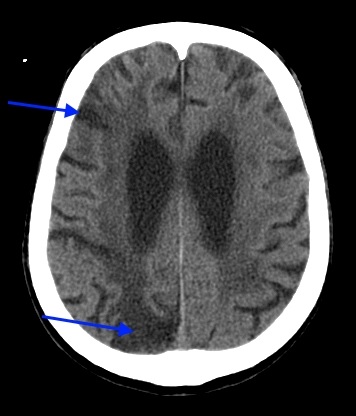 On the CT scan at the level of the bodies of the lateral ventricles, blue arrows indicate cystic (atrophic) areas in the parietal and occipital lobes on the right (consequences of a stroke). There are also signs of chronic cerebral ischemia, more pronounced on the right (periventricular leukoaraiosis).
On the CT scan at the level of the bodies of the lateral ventricles, blue arrows indicate cystic (atrophic) areas in the parietal and occipital lobes on the right (consequences of a stroke). There are also signs of chronic cerebral ischemia, more pronounced on the right (periventricular leukoaraiosis).
 CT scan of the head at the level of the 4th ventricle, cerebellar peduncles: in the left hemisphere of the cerebellum (at the base, near the left cerebellar peduncle) there is an atrophic area (consequences of a stroke). Pay attention to how the external cerebrospinal fluid spaces of the brain are expanded.
CT scan of the head at the level of the 4th ventricle, cerebellar peduncles: in the left hemisphere of the cerebellum (at the base, near the left cerebellar peduncle) there is an atrophic area (consequences of a stroke). Pay attention to how the external cerebrospinal fluid spaces of the brain are expanded.
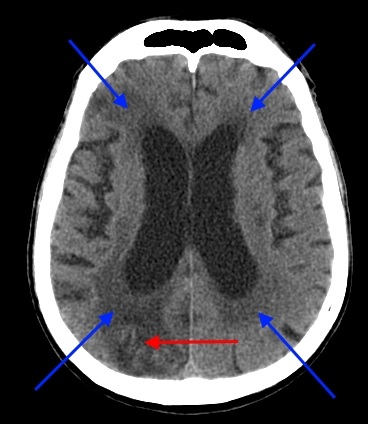 Blue arrows on the CT scan indicate areas of periventricular leukoaraiosis (around the anterior and posterior horns of both lateral ventricles). The red arrow also indicates "fresh" (on the right in the occipital lobe).
Blue arrows on the CT scan indicate areas of periventricular leukoaraiosis (around the anterior and posterior horns of both lateral ventricles). The red arrow also indicates "fresh" (on the right in the occipital lobe).
The presence of dystrophic focal changes in the brain in many cases is a consequence of chronic ischemia and is often combined with atrophic (replacement) hydrocephalus, especially in people who take alcohol long time who are exposed to intoxications of a different nature, who have had a stroke earlier or a head injury.
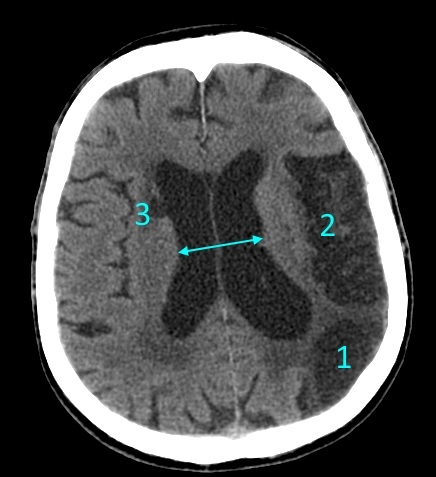 On the scan (CT) of the head - signs replacement hydrocephalus(due to necrosis of the brain parenchyma), with the presence of multiple foci of an atrophic nature on the left side - in the occipital lobe (1), in parietal lobe(2) and with right side– in the region of the head of the lenticular nucleus, periventricular to the body of the ventricle (3). The diameter of the lateral ventricles is expanded (marked with an arrow). Around the horns of the lateral ventricles there is a hypodense (low density on CT) zone.
On the scan (CT) of the head - signs replacement hydrocephalus(due to necrosis of the brain parenchyma), with the presence of multiple foci of an atrophic nature on the left side - in the occipital lobe (1), in parietal lobe(2) and with right side– in the region of the head of the lenticular nucleus, periventricular to the body of the ventricle (3). The diameter of the lateral ventricles is expanded (marked with an arrow). Around the horns of the lateral ventricles there is a hypodense (low density on CT) zone.
Results
Dystrophic focal changes can be detected by CT and MRI in the brain of any person. Their detection may indicate a past pathology (traumatic, ischemic). If the foci are small in size and localized in peripheral departments brain or in the white matter, basal ganglia, prognosis for later life the patient is favorable. But focal changes in the stem localization, on the legs of the brain, the thalamus are more unfavorable and may be the cause of the appearance of neurological symptoms.
Vascular genesis refers to all possible associated with vessels. What is this disease? Vascular genesis means a violation of blood flow in, namely, in its vascular and venous network. Now let's take a closer look at this pathology.
What is vascular genesis?
If a person has dizziness, a noticeable deterioration in memory, a slow reaction and fatigue appear, then perhaps he has a permanent deficiency in the nutrition of the brain. Many people take these signs lightly. They attribute them to workload or lack of vitamins. In order for the brain to function properly, it needs energy. The blood provides it nutrients and oxygen. The body's work system is designed in such a way that the nutritional process of the brain is carried out through 4 arteries. Failure of the blood supply leads to various diseases. As a result, vascular genesis occurs.
That's why primary symptoms associated with headache and fatigue should not be ignored. It is necessary to make a visit to the doctor. He should be asked to conduct the necessary examination, perhaps the person has a vascular genesis. Identification of disorders in the body early stage makes the treatment process more fruitful. It makes it possible to fully restore the body. Therefore, it is better to start treatment immediately if a vascular genesis of the brain is detected. What is it, the doctor can explain, he will prescribe necessary measures for the treatment of the disease.
Impaired blood supply to the brain
The main causes of malnutrition are hypertension and atherosclerosis. The first named ailment is quite common. This disease affects both men and women. The origin of hypertension is often unknown. But it can cause a person to be diagnosed with vascular genesis. The essence of hypertension is that the walls of blood vessels thicken, and the channel through which blood flows narrows. Sometimes there is a complete narrowing. In this case, the passage of blood is made impossible. Next comes the vascular genesis of the brain. What is it, we described above.

Atherosclerosis is associated with impaired lipid metabolism. because of advanced level cholesterol in the blood and other substances containing fat, deposits form in the vessels. They interfere with normal blood circulation. Its movement is hampered by the fact that plaques form in the vessels over time due to lipids. First, they clog blood vessels. Then they start to fall apart. Their particles with blood are carried to other small vessels. As a result, they can cause blockages.
Also, a disease such as osteochondrosis can affect the blood supply to the brain. Since the movement of the intervertebral discs can lead to pinching of the arteries. Thus, the nutrition of the brain will deteriorate.
Symptoms of circulatory disorders
With insufficient nutrition of the brain, neurons begin to die. Since the latter are associated with neurology, the patient may experience irritability, fatigue, insomnia, or interrupted sleep. Also for such a state of depression are frequent contributing factor. If the disease progresses, then a person may experience periods of strong excitability.

There is also a manifestation of egocentrism. At further development disease comes indifference to anything and dementia. Insufficient nutrition of brain cells can cause other more serious illnesses. For example, a stroke. In our country, this disease is quite common. Not everyone can survive this disease. Moreover, it can lead to various grave consequences both for the person himself and for his inner circle. There may also be epileptic seizures due to the fact that the brain does not receive enough nutrition.
Types of circulatory disorders
Classify the types of malnutrition of the brain as follows:

stages
There are several stages that indicate the development of a disease associated with malnutrition of the brain. The dynamics can be different, as it is influenced by some factors, such as heredity, lifestyle, ecological situation and so on.
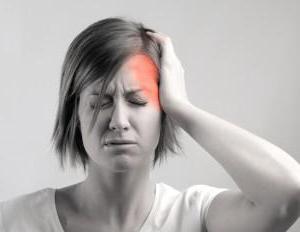
In the first stage of the disease, people often have a headache, irritability, forgetfulness, and sleep disturbance. On the second memory worsens with greater force, a person can sleep during the day, and sleep is disturbed at night. Also appear intrusive thoughts, the patient begins to think about the same problem. The gait becomes unsteady. There is a lack of coordination of movements. Decreased performance. On the last stage disease, dementia sets in, a person ceases to recognize relatives and navigate the street.
Causes of the disease
As mentioned above, this disease has any reason. That is, insufficient nutrition for the normal functioning of the brain is associated with any disorders of the body. These include:
- Increased blood pressure.
- Diseases of the heart system such as arrhythmia, ischemic disease hearts and others.
- Diabetes.
- Excess weight.
- Sedentary lifestyle, lack of walks, sports, etc.
- The presence in the body of high cholesterol. This indicator associated with malnutrition, as well as the presence of fatty foods in the human diet.
- Heredity. If close relatives have suffered diseases such as stroke and heart attack, then there is a possibility of this disease.
- Availability bad habits such as alcohol and smoking.
- In men, in addition to the above causes of malnutrition of brain cells, there is such an indicator as emotional overstrain. This is primarily due to stress at work and at home. As a rule, a man feels responsible for the well-being of the family. Therefore, problems at work can affect his health.
Diagnostics
It can be difficult to identify that the brain receives little nutrition, and it is difficult to determine changes in vascular genesis at the initial stage, since with given state body electrocardiogram can be completely normal, without any abnormalities. But the ECG during exercise can reflect the changes that are present in the human body. It is also recommended to put a daily monitor so that the doctor can see the work of the heart. But it is worth saying that these types of diagnostics may not show that some kind of malfunction occurs in the body, for example single focus vascular genesis.

Other diagnostic methods
An examination of the fundus will help in the diagnosis. This event will help to identify whether there are any changes in the brain or not. Also, the patient may have impaired hearing and impaired swallowing reflex. Therefore, it makes sense to be examined by an otorhinolaryngologist. Also, if there is a suspicion of the presence of any abnormalities in the brain, the doctor should prescribe blood tests.
![]()
Computer diagnostics is good method detecting changes in a person. With it, you can see the supratentorial foci of the vascular origin of the brain.
Conclusion
Now you know what vascular genesis is, how it manifests itself. We also examined the features of diagnosing this disease, its causes and symptoms.
Vascular genesis is a term indicating the cause of a disease caused by blood flow disorders or vascular damage. Vascular genesis can be caused by disorders of all organs and systems.
Most dangerous consequences diseases of vascular origin are complete (partial) paralysis of the body and leukoencephalopathy (lesion white matter in the subcortical structures of the brain).
Causes of the problem
Pathological changes in the vessels are a consequence of the influence of such factors:
- hypertension;
- diabetes;
- the presence of bad habits (in particular, alcoholism);
- obesity;
- experiences, stress;
- lipid metabolism disorder;
- weather dependence;
- sedentary lifestyle;
- head injury;
- drug use.
Violation of blood circulation in the brain occurs against the background of:
- blood diseases;
- vasculitis;
- heart defects;
- cervical osteochondrosis.
Diseases vascular origin appear in the form:
- blockage of arteries, disturbances in the process of nutrition of certain parts of the brain;
- rupture of blood vessels with hemorrhage (ischemic, hemorrhagic strokes);
- transient (transient) disorders of the blood supply to brain structures.
Violations relating to last group may be cerebral or focal. Distinctive feature such diseases are reversible. Properly selected treatment allows you to fully restore lost functions.
Clinical picture
May cause these symptoms:
- High blood pressure ( upper indicator reaches the level of 140 mm Hg. Art. and above) - arterial hypertension develops.
- Violation of the heart rhythm (arrhythmia).
- Constant headaches, fatigue, decreased sensitivity and a feeling of weakness in the limbs.
- Memory and attention disorders.
One of the most revealing signs of vascular pathologies that have developed in the brain is the nature of the headache. So, its pulsating nature signals a change in the tone of the craniocerebral arteries. Along with pulsation, the patient experiences a sensation of squeezing in the head, ringing appears (disappears) in the ears.
When subject to pulse stretching, squeezing it can stop the pain.
Severe stages of vascular pathologies are associated with a violation of the permeability of the walls of the arteries. The nature of the headache is modified: it becomes dull, bursting; it is accompanied by nausea, vomiting; black dots flash before the patient's eyes.
gravity, pain in the back of the head - a sign of excessive fullness of the blood of the veins of the brain. At the same time, the localization of pain does not indicate the lesion - it is just a projection.
Painful symptoms in the back of the head may occur in the morning - venous outflow with vertical position body is more efficient.
Another symptom of vascular diseases are mental disorders(they are secondary). Their cause is a violation of blood flow in the brain.
In patients with vascular pathologies, the following manifestations may be detected:
- sleep disturbance;
- sensitivity to stimuli (light, sound);
- irritability, tearfulness, low concentration of attention;
- memory problems;
- personality changes - a hypertrophied manifestation of certain character traits (anxiety, suspiciousness, self-doubt).
Diagnostic measures
Timely diagnosis of vascular pathologies is complicated by the absence of severe symptoms and the absence of periods of exacerbations. To make a diagnosis, the doctor not only takes anamnesis and traces the dynamics of the patient's well-being, but also prescribes a number of hardware studies.
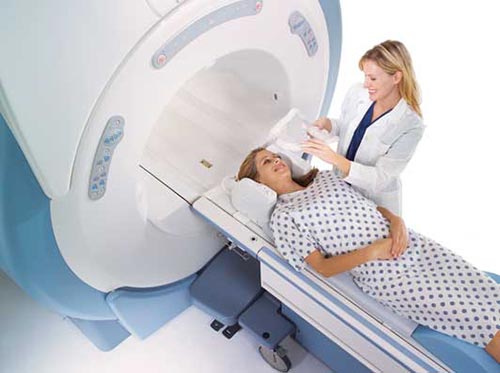
So, to identify diseases of vascular origin help:
- Ultrasound procedure.
- Study of the electrical activity of brain regions.
- Spectroscopy.
- Methods of thermal imaging survey.
- Scanning.
A promising technique is magnetic resonance angiography. This technology allows you to detect changes in the structures of the brain and its vessels.
In order to detect diseases of vascular origin, specialists use CT. Thanks to computed tomography brain structures are scanned using x-rays(to determine the speed of radiation fluxes through soft tissues brain).
CT allows the specialist to make a conclusion about the congenital or acquired nature of vascular pathology.
Treatment
After confirming the diagnosis, the patient is shown therapeutic measures aimed at minimizing the symptoms of hypertension and atherosclerosis. In addition, it is necessary to restore lipid metabolism in the body (food + drugs).
Treatment of vascular diseases involves the removal atherosclerotic plaques, restoration of blood flow. maybe surgical intervention, in which part of the damaged vessel is removed. It is followed by rehabilitation period, the components of which are physiotherapy, physiotherapy exercises.
The general scheme for the treatment of diseases of vascular origin is as follows:
- Correction of the daily routine. The patient is shown: a calm environment, no stress, physical exercise. For transient disorders bed rest until the disappearance of neuralgic symptoms (vomiting, nausea).
- Revision of the scheme and diet. Vascular pathologies- consequence of violation fat metabolism. The patient is recommended a treatment menu.
- Medical therapy. It is selected depending on the nature of the damage and the focus of their localization. Thus, patients with impaired venous outflow xanthine drugs (Eufillin) are prescribed if we are talking about the arteriohypotensive variant of the course of the disease - Sumatriptan, Ergotamine. When the symptoms of the disease are caused by arteriospastic problems, antispasmodics are indicated (Papaverine, No-shpa).
- Surgical treatment is provided for the purpose of removing atherosclerotic plaques.
So, the vascular genesis of the brain is not called the disease itself, but rather etiological factor that prompted its development. This term covers various pathologies(from atherosclerosis to stroke) requiring diagnosis and treatment.

